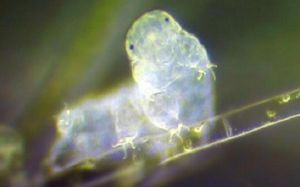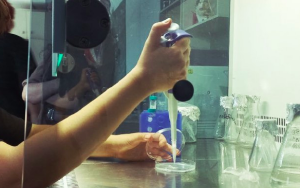Tardigrades are invertebrate microscopic animals popularly known as water bears and notorious for their incredible ability to survive in extreme conditions. These organisms measure between 0.3 mm and 0.5 mm, although some can reach up to 1 mm. They are characterised by a cylindrical body, segmented into four pairs of legs with claws at the ends.
Their body is covered by an external cuticle, which they shed periodically. They are bilaterally symmetrical and have a complete digestive system, but lack a respiratory and circulatory system. Instead, they obtain oxygen by diffusion through their skin. They are aquatic animals and live in humid enviromets such as mosses, lichens, wet soils and even in seawater and freshwater, where they feed on plant cells or small invertebrates.
They have become truly remarkable for their high resistance to extreme environments such as freezing at temperatures close to absolute zero, high temperatures up to 150°C, extreme dehydration, starvation for decades, high levels of radiation and space vacuum, extreme pressures, both high and low... This is made possible by their ability to shut down their organs and stop their metabolism when environmental conditions are not suitable (this is called cryptobiosis) and come back to life when optimal conditions are restored. One of the reasons these organisms are so resilient is because of a protein that only they produce. These abundant heat-soluble cytoplasmic proteins (CAHS) cause the inside of the cells to turn into a gel, which prevents the cell from collapsing.
The reproduction is mainly sexual, although in some species asexual reproduction by parthenogenesis is observed. Females lay their eggs during cuticle shedding, and fertilisation occurs within the cuticle, or in the external environment in some species.
The study of tardigrades has attracted great interest due to their extraordinary resilience, which could have applications in biomedicine, astrobiology and tissue preservation technologies. They are also used as biomarkers to study the impact of climate change and pollution in extremophile environments.
In the laboratory, we could take care of some of them. First we disolve the initial sample which had a huge amount of tardigrades and as food they had algae. Then some of them were "sacrifice" as a contaminated sample so we could observe them through the microscope.
At the begining they where looking full of food but after a month in this sample we found most of the tardigrades went to sleep mode probably due to lack of food.
Alessandro's input:
We got clean tardigrade cultures of Hypsibius exemplaris and the algae on which they feed, Chloloroccum sp.
Each week we removed some water from the tardigrade flask, and add some water from the Chlorococcum flask. This way we feed them. The number of tardigrades in the culture increased significantly.
Chlorococcum was cultivated by refilling the missing water with spring water with 0,01% of plagron algal fertilizer.
Then you can say which impression did you have while looking at it and learning about them
Webgraphy_
Montejo, E. (2022, 22 septiembre). Científicos revelan el secreto que hace inmortal a los tardígrados. National Geographic En Español. https://www.ngenespanol.com/animales/descubren-por-que-los-tardigrados-son-practicamente-indestructibles-y-sobreviven-a-condiciones-extremas/
Wikipedia collaborators. (2024, 3 septiembre). Tardigrada. Wikipedia, la Enciclopedia Libre. https://es.wikipedia.org/wiki/Tardigrada



